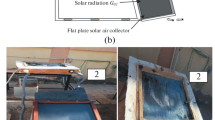Abstract
A study has been done over the 9-h cycle for the solar still and calculates their output for an individual hour. The values of solar intensity, coefficient of heat transfer, ambient temperature, depth of water, and the coefficient of heat transfer through the walls of base and sides of the water basin are measured from the approximate method for each hour and later check their performance. In the previous methods, we required the graphical constructions and also constant coefficients of heat transfer assume but this thing is not required in this proposed method and observed the coefficients of heat transfer value for all the earlier time interval in the equations of heat balance is must. Actually, observed the two alternatives method of calculation is obtained evaporation rate for each an hour. From the energy balance equations, we compared the results from one which is found by mathematical solution. By using the energy balance equations, results which are calculated are different from the results obtained from the 9-h cycle of the approximate method and having the ±1.5% error. Water depth is 5–15 cms, coefficient of heat transfer in wind is 5–40 W/m2 K and the coefficient of heat transfer through side and base walls is 0–3 W/m2 K; these are variable ranges which taken for the analysis.
Access this chapter
Tax calculation will be finalised at checkout
Purchases are for personal use only
Similar content being viewed by others
References
Dunkle, R.V.: Solar water distillation: the roof type still and a multiple effect distillation still. In: International Developments in Heat Transfer, Papers presented at the 1961 Int. Heat Transfer Conference, University of California, Part V, pp. 895–902 (1961)
Lof, G.O.G., Eibling, J.A., Bloemer, J.M.: Energy balances in solar distillers. AICHE J. 7(4), 641–649 (1961)
Morse, R.N., Read, W.R.W.: A rational basis for the engineering development of a solar still. Sol. Energy 12, 5–17 (1968)
Cooper, P.I.: Digital simulation of transient solar still processes. Sol. Energy 12, 313–331 (1969)
Sharma, V.B., Mullick, S.C.: Estimation of heat transfer coefficients, the upward heat flow, and evaporation in a solar still. ASME J. Solar Energy Eng. 113, 36–41 (1991)
Kumar, A.: Physics of the solar still. Ph.D. Thesis, Centre of Energy Studies, Indian Institute of Technology, Delhi (1981)
Duffie, J.A., Beckman, W.A.: Solar Engineering of Thermal Process, New York (1980)
Kreith, F., Kreider, J.F.: Principles of Solar Engineering. Hemisphere, New York (1978)
Keenan, J.H., Keyes, F.G.: In Thermodynamic Properties of Steam. Wiley, New York (1936)
Author information
Authors and Affiliations
Corresponding author
Editor information
Editors and Affiliations
Appendices
Appendix 1
-
In a basin-type solar still, the energy balance and the individual heat transfer coefficient
In Fig. 10.7, thermal circuit diagram for a basin-type solar still is mentioned, and it is because of Dunkle in 1961 [1]. The coefficient of heat transfer of radiation, convection, and evaporation is given by the following equation between the water and glass cover “(Duffie and Beckman [7], Dunkle [1], Kreith and Kreider [8]).”
between the atmosphere and the glass cover of solar still, the coefficient of radiative heat transfer is given by the following equation,
coefficient of radiative heat transfer is located to surrounding temperature particularly for flat plate collectors which is given by,
for small values of (Tg − Ta); this method gives a large value of hrga. The sink temperature is higher than the actual sink temperature means (Ta ˃ Ts); due to this, the large value of hrga is obtained. The sink temperature is used in the earlier work of Sharma and Mullick [5] in 1991 as a sky temperature (Ts) for thermal network which is the lowest temperature. Among all calculations, this method gives the better results related to the present problem; during the nighttime, this approach gives better results under such conditions. The wind heat transfer coefficient is given by the following relation, because the sink temperature is used like ambient temperature,
from the Swinbank 1963, the ambient temperature in this work is given by,
-
Equation formed for Latent heat and Water vapor Pressure as the temperature function.
Keenan and Keyes [9] in 1936 gives an empirical relation for partial pressure of water for the temperature limit of (10–150) °C is shown by the below equation,
in the above equation, the constants a, b, c, d, and X having the values of 3.2437, 5.8682 × 10−3, 1.1702 × 10−8, 2.1878 × 10−3, and 647.27, respectively; temperature (T) is measured in Kelvin.
In this current work for latent heat of vaporization, the relation given by Sharma and Mullick in 1991 [5] is as follows,
Appendix 2
-
Calculate the data of solar insolation and ambient temperature
For 24-h period, for the mathematical solutions, it is easier to have ambient temperature and solar intensity in form of continuous functions. From the Fourier series with the 6 harmonics, the data of Delhi of June month for the clear day is shown by,
where radius (r) = π/180 and w = 2π/(24 × 3600).
so, continuous functions are shown in Fig. 10.2.
Rights and permissions
Copyright information
© 2020 Springer Nature Singapore Pte Ltd.
About this paper
Cite this paper
Khan, M.Z., Khan, E.H., Agarhari, N., Wahid, M.A., Nawaz, I. (2020). Calculation for the Output of Solar Still of an Individual Hour. In: Singh, I., Bajpai, P., Panwar, K. (eds) Advances in Materials Engineering and Manufacturing Processes. Lecture Notes on Multidisciplinary Industrial Engineering. Springer, Singapore. https://doi.org/10.1007/978-981-15-4331-9_10
Download citation
DOI: https://doi.org/10.1007/978-981-15-4331-9_10
Published:
Publisher Name: Springer, Singapore
Print ISBN: 978-981-15-4330-2
Online ISBN: 978-981-15-4331-9
eBook Packages: EngineeringEngineering (R0)





